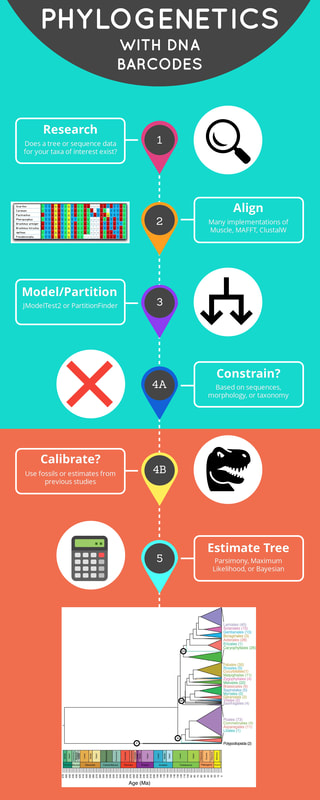|
By Bethan Littleford-Colquhoun
A huge debt of gratitude to Beth for organizing a google drive folder that shares our strategy for initial processing of dietary DNA metabarcoding data. This directory provides template documents and code that we use to download paired-end read data from our dietary metabarcoding workflows, assemble forward and reverse reads, perform initial quality controls, and evaluate sequencing success. There is also a tutorial for how to upload sample data to SRA for archiving, which we have started to do routinely. Some details are specific to our dietary analysis sequencing workflow and/or the specific sequencing service that we use, plus we have particular sample naming schemes that we use, but it should be pretty straightforward to adapt for a variety of similar goals.
0 Comments
As part of Beth's critical review in Molecular Ecology on abundance-filtering strategies in DNA metabarcoding pipelines, we conducted simulations and sensitivity analyses to illustrate how key assumptions in the design of our bioinformatic strategies can introduce biases that undermine ecological interpretations of the data.
The Dryad repository for the paper contains data and code that will be useful for anyone who would like to replicate or enhance the simulations and/or sensitivity analyses. I consider this a major bioinformatic resource for researchers in the field, and an illustration of thoughtful research strategies that I hope others will build upon in a few key ways. The simulations we conducted are relatively simple, but extremely relevant. It would be rewarding to explore the relevance of other assumptions, parameters, data structures, and/or downstream ecological metrics. This would not only be of fundamental interest, but the developments and insights would be profoundly useful for all researchers in the field (us included). The Reviewers and Editors of this original manuscript seemed to agree with that sentiment. We briefly considered publishing an R Shiny App or similar to facilitate this type of exploration -- I still think it could be worthwhile, so please let us know if you would like to contribute! The sensitivity analyses model a strategy that I developed piecemeal over the years to help me check my assumptions about how robust my published conclusions would be and to be more persuasive with reviewers. Similar sensitivity analyses have been described in the supplementary materials in several publications in recent years. It requires a bit more work than simply using a plug-and-chug approach to bioinformatics and downstream analyses, but I think it pays off in terms of my own understanding of each study system and the reliability of my papers. I often encourage authors of papers that I review to consider doing something similar when their results are borderline, and I hope this code can serve as a resource to support that type of effort when appropriate.
Bianca Brown began the hard work of collating scripts the lab uses to process fastq data from our lab's diverse Illumina amplicon projects. These strategies, and a draft explanation of why we use different "flavors" of these approaches for different projects, are provided here.
Modules included the tutorial include "cutadapt," "dada2," and "R," with some references to "Obitools" and Brown University's supercomputing cluster "Oscar." Many of the steps and principles of these workflows are identical -- we want to thoughtfully prepare our data for analysis and remove errors -- but a few of the nuts and bolts differ. Most often, these differences arise from whether or not a project included single-end sequence data (used to be common) or paired-end sequence data (now standard in the lab). There are also differences in approaches depending on whether the amplicons are typically invariable in length (e.g., 16S-V4 rRNA or COI markers), or if there is considerable length variation (e.g., trnL-P6 markers). For members of Brown University seeking to run parts of these modules on Oscar, Bianca has very kindly provided some blank bash scripts that can get you started here. NB: This compilation of scripts is a work in progress. We are aware of necessary updates and improvements, and we intend to push them soon. We'll add posts describing any substantial updates in the future, and we welcome feedback. We also wish to express our appreciation to all of the authors of the softwares that we use and cite in our work. |
AuthorComputational resources kindly contributed and explained by members of our community. Archives
May 2023
Categories
All
|

 RSS Feed
RSS Feed
